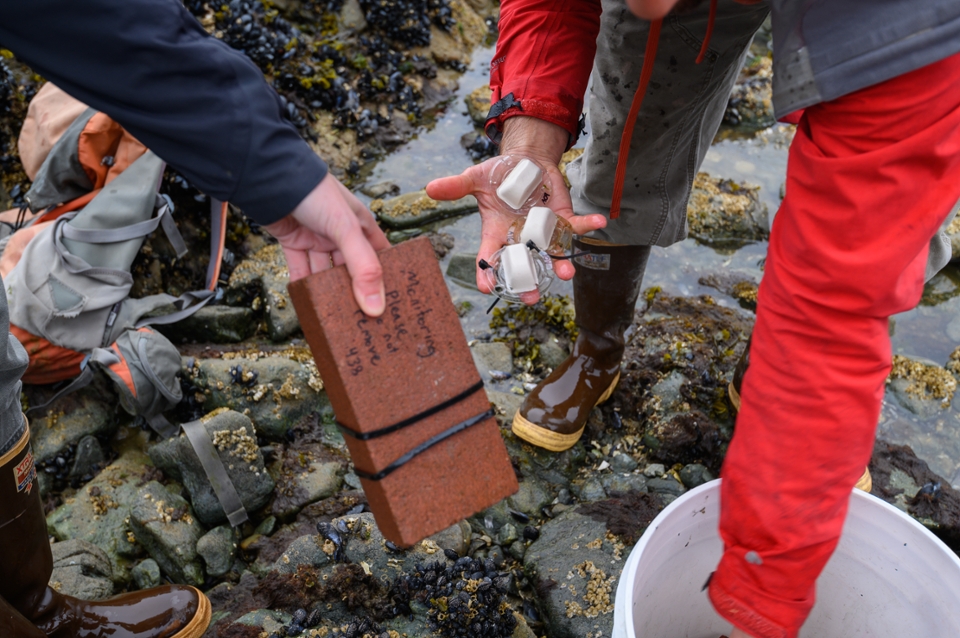Paralytic shellfish toxins spike amidst new research

Shellfish harvesters and beachcombers wandering the shores around Juneau might have made an odd discovery this summer– a small white hunk of plaster under the water, strapped to a neatly labeled brick. These contraptions are part of an effort to better monitor and predict paralytic shellfish poison (PSP) levels, which were almost ten times higher this summer than at any time in the last three years.
During a summer of climate extremes in Alaska, including the warmest July on record for the state, warm ocean temperatures created ideal conditions for large Harmful Algal Blooms (HABs). Some algae blooms, such as the dinoflagellate Alexandrium, produce a suite of toxins known as paralytic shellfish toxins that accumulate in shellfish and make them toxic for human consumption.
PSP measurements in blue mussels at sites around Juneau reached 4,500 micrograms per 100 grams of shellfish tested in June, surpassing the previous highest recorded level from Juneau in the last three years by 4,000 micrograms. That’s toxic enough to be fatal to a person after only consuming a few mussels. ACRC postdoctoral researcher Dr. John Harley is looking at how environmental factors like ocean temperature, wave action, and solar energy affect shellfish toxicity. What conditions drive these high-intensity spikes in PSP levels? And why do shellfish in some areas become toxic, while others nearby are safe to eat?
Harley uses toxin data from the Southeast Alaska Tribal Ocean Research (SEATOR) network, a tribally-organized monitoring network that samples and reports on shellfish toxin levels around the Panhandle. Combined with available information on environmental conditions for the past few years, Harley is using the SEATOR data to create a tool to help map and predict PSP events in the region.
As Harmful Algal Blooms become more frequent, severe, and widespread, a broad understanding of what drives PSP toxicity is crucial for safe harvesting. Understanding small variations in how shellfish accumulates toxins across a single beach could improve monitoring efforts and harvesting practices.
That’s where the plaster cubes come in. Known as Clod cards, they are part of an experiment to measure how exposure to waves and wind may alter how shellfish accumulate toxins on a small scale at beaches around Juneau.
With the help of UAS undergraduate interns Mollie Dwyer and Liz Bryson, Harley measured toxins and wave exposure at four beaches throughout the summer. At each beach, they tested shellfish samples from a protected area, like a bay, and an exposed area, such as a point. Weighted with bricks and left in the water at adjacent sites, the Clod cards dissolved at varying rates based on how exposed the site was and how much wave energy hit the site over the course of a few days. After 24-48 hours, the team returns to collect the molds, take salinity and temperature measurements, and collect shellfish near each sampling point. How much of the plaster dissolved in the water at each site, compared with how high toxin levels were in the mussels collected nearby, demonstrate how wave action and water movement is related to PSP concentrations.
“We’re still gathering data, but what we are seeing so far is that during the bloom, or right before or after, you are more likely to find higher concentrations of toxins at more exposed sites,” said Harley. This makes sense– more exposure means more water is moving past shellfish in that site. Shellfish are filter feeders, so with more water flow, they are likely ingesting more of the microscopic marine algae that carry the PSP toxins. Thus, when a HAB begins, shellfish at these exposed sites are likely to accumulate toxins earlier and at a faster rate than in more protected waters.
Harley’s work is not just important for harvesters, but can also inform monitoring efforts of groups like SEATOR. The difference between collecting samples from one side of a beach to the other could alter whether the site is labeled as having safe or unsafe toxin levels.
Many harvesters and commercial shellfish growers rely on SEATOR data to avoid contaminated shellfish. The SEATOR lab is the only toxin testing site in the state outside of the Department of Environmental Conservation (DEC) in Anchorage.
“It’s telling that before the SEATOR program started, most of the cases of PSP in Alaska were from Southeast and Kodiak. Since this program started in 2016, we haven’t seen any reported cases of PSP at any of the participating communities,” said Harley.